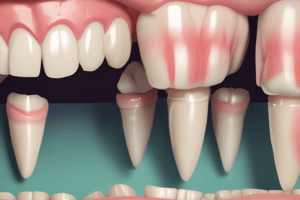Podcast
Questions and Answers
What is the main aim of tooth preparation for inlays and onlays?
What is the main aim of tooth preparation for inlays and onlays?
- To create deep undercuts in the cavity walls
- To remove as much tooth tissue as possible
- To speed up the process of indirect restoration
- To give an adequate amount of protection to the tooth (correct)
Why should the preparation of opposing cavity walls be cut to avoid undercuts?
Why should the preparation of opposing cavity walls be cut to avoid undercuts?
- To add complexity to the process
- To make the restoration process faster
- To ensure optimum retention from the cavity shape (correct)
- To reduce the strength of the final restoration
What type of cavity shape is recommended for inlays and onlays completed with all-ceramic material?
What type of cavity shape is recommended for inlays and onlays completed with all-ceramic material?
- Irregular shape
- Highly undercut shape
- Parallel walls shape
- Slightly under-tapered shape (correct)
Why must the preparation shape have parallel walls for indirect restorations using gold material?
Why must the preparation shape have parallel walls for indirect restorations using gold material?
What is the purpose of a provisional restoration made using materials like ProTemp?
What is the purpose of a provisional restoration made using materials like ProTemp?
At which appointment during the process are putty and wash impressions taken of the prepared tooth?
At which appointment during the process are putty and wash impressions taken of the prepared tooth?
What is the recommended range for occlusal reduction during tooth preparation?
What is the recommended range for occlusal reduction during tooth preparation?
What angle should the bur be held at to create a functional occlusal bevel on the occlusal loading cusp of molar teeth?
What angle should the bur be held at to create a functional occlusal bevel on the occlusal loading cusp of molar teeth?
Which type of bur is preferred for creating a functional occlusal bevel on molar teeth?
Which type of bur is preferred for creating a functional occlusal bevel on molar teeth?
Which cusp should be considered when creating a functional occlusal bevel on mandibular teeth?
Which cusp should be considered when creating a functional occlusal bevel on mandibular teeth?
What is the most convenient shape of bur for preparing buccal, lingual, and proximal reduction of the tooth?
What is the most convenient shape of bur for preparing buccal, lingual, and proximal reduction of the tooth?
What approach can be taken to eliminate undercuts from the preparation during inlay preparation?
What approach can be taken to eliminate undercuts from the preparation during inlay preparation?
Study Notes
Preparation for Inlays and Onlays
- The goal of tooth preparation is to preserve more tooth tissue while providing adequate protection, compared to a crown preparation.
Tooth Preparation
- Start with occlusal reduction, ranging from 0.5mm-2mm depending on the restorative material used.
- Use a high-speed diamond fissure bur, following the inclination of the cusps and grooves to preserve tooth tissue.
- Create a functional occlusal bevel on the occlusal loading cusp of molar teeth, holding the bur at a 45o angle to the occlusal surface.
Reduction of Cavity Walls
- Prepare opposing cavity walls to avoid undercuts, ensuring optimum retention from the cavity shape for the indirect restoration.
- For all-ceramic restorations, cavity shapes can be slightly over-tapered, as most retention comes from the cement lute.
- For gold restorations, prepare parallel cavity walls, as most retention comes from the cavity shape.
Appointment Process
- The process typically involves two appointments: preparation at the first visit, and cementation at the second.
- Take a putty and wash impression of the prepared tooth at the first visit, to be sent to the laboratory for fabrication.
- Create a provisional restoration using material like ProTemp to protect the tooth and maintain aesthetics.
Converting a Class II Restoration
- When preparing an inlay, the existing Class II restoration is removed, and the cavity is converted by eliminating undercuts.
- This can be done by either blocking undercuts with an adhesive restorative material or removing tooth tissue to create a divergent cavity.
Studying That Suits You
Use AI to generate personalized quizzes and flashcards to suit your learning preferences.
Description
Learn about the tooth preparation process for inlays and onlays, focusing on preserving tooth tissue and providing adequate protection. Understand how to cut opposing cavity walls to avoid undercuts for optimal retention of indirect restorations.


